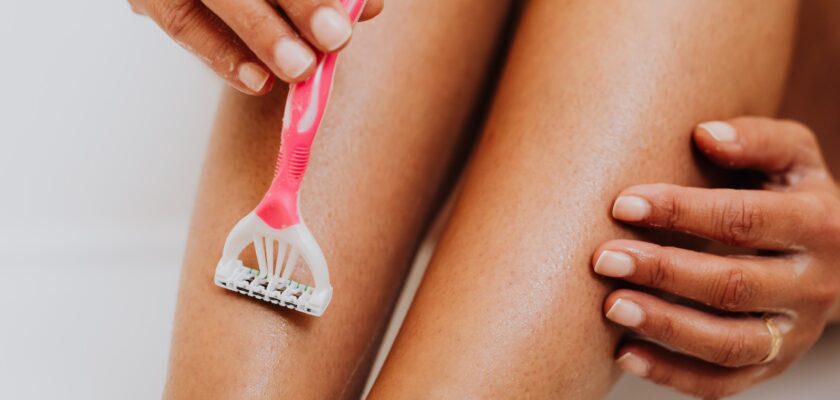Razor bumps are a common problem associated with hair removal techniques such as shaving, waxing, and tweezing. Thankfully, they are usually harmless and do not require professional medical treatment.
Some home remedies for razor bumps include soaking the affected area in colloidal oatmeal baths, which contain phenol that has anti-inflammatory properties, and applying a cold or warm compress to soothe the skin. A hydrocortisone cream can also decrease irritation and inflammation.
1. Cleanse
As a part of the body, the vagina should be cleaned daily. Wash it using warm water and mild or unscented soap in the shower, or use a washcloth to gently clean the vulva folds and clitoral hood. Be sure to rinse well. Avoid scented products, as they can irritate your sensitive vulva skin. Make it a point to clean after sex, especially if you’re a guy (you might want to change your undies before). This can help prevent bacteria and yeast infections.
If you’re prone to razor bumps, consider taking a break from shaving – These words are the work of the service specialists Sultry Sensations. This can give your skin a chance to heal from the irritation that causes them. Plus, it allows hairs that were cut short by your last shave to grow out and move away from under the skin. After a few weeks, you may notice that the razor bumps are gone. This is because they’re not being trapped under the surface of your skin anymore. Continuing to shave irritated skin can only cause more bumps. Also, if you’re using an electric razor, make sure you’re following the manufacturer’s instructions for use.
2. Exfoliate
The vulva is sensitive, so choose an exfoliating scrub that’s targeted for the area. You can find one in the store or try a homemade recipe such as baking soda and olive oil (just make sure you’re not touching the inner labia).
Razor bumps, also known as pseudofolliculitis barbae, develop when hair grows back into the skin instead of up and out. They may appear on the face, head, arms, legs, and other areas that get shaved, but are particularly common on the crotch. They can cause pain and are often mistaken for STDs like herpes or other infections.
In a recent Instagram video, millennial dermatologist and influencer Tanaya Narendra, aka Dr Cuterus, shared some ways to prevent razor bumps. She suggested shaving in the direction of the hair growth and exfoliating before a shave to reduce the risk. She also recommended avoiding shaving too frequently, using a sharp and clean razor, and applying a warm compress to alleviate inflammation.
3. Moisturize
A cool compress or aloe vera can reduce inflammation and help sooth razor bumps. You can also use a moisturizing product that’s formulated for the vagina. Look for one that contains hyaluronic acid to increase moisture retention and make your skin more elastic, explains a menopause expert.
If you notice that your razor bumps are red, it may be a sign of infection or irritation. If the rash is painful and tender to the touch, it may be herpes or another STD.
If you suspect you have herpes, take a shower and wash your vulva area thoroughly with an unscented bath soap or lotion. Avoid using bath salts or bubble bath and use a gentle scrub or loofah to exfoliate your skin. If the rash does not subside, talk to your doctor. The best way to prevent herpes is to maintain good hygiene and get regular STI screenings. If you’re worried about getting herpes, contact your doctor for more personalized support. They can help determine the cause of your symptoms and recommend treatment options.
4. Apply Tea Tree Oil
The vagina has a delicate balance of bacteria and pH levels. Disrupting this balance can lead to a variety of ailments including bacterial vaginosis, yeast infections, and itching. Tea tree oil has antifungal and antibacterial properties, which can help kill harmful bacteria and relieve itching in the vagina. However, it is important to use this natural remedy with caution. Undiluted essential oils can be irritating to the skin, so it is recommended that you perform a patch test before applying the oil to your intimate areas.
Another simple treatment is to use apple cider vinegar to soothe irritated skin. The acetic acid in the vinegar can also help reduce razor bumps. Apply the vinegar to a cotton ball and rub on the irritated area several times a day.
5. Exfoliate Again
Using a loofah, washcloth, or gentle scrub after shaving can help get rid of any lingering dead skin cells. A toner is also a great way to eliminate the excess dead skin that builds up with razor bumps. Carla and Wendy Nelson recommend the Paula’s Choice toner that has a high pH level that helps exfoliate and prevent razor burn in the vulva area.
Razor bumps are inflamed hair follicles that look like pimples and can happen after shaving, waxing, or even ingrown hairs. They can cause pain and itching in the genital area.
Applying a warm compress can help reduce redness and irritation, and using a shaving cream that contains aloe or an over-the-counter (OTC) cortisone can decrease inflammation as well. If a razor bump becomes infected, apply a topical antibacterial ointment or antibiotic cream to the bump. It’s important to avoid popping razor bumps, which can lead to infections and scarring. You should also avoid tweezing, as unsterilized tweezers can introduce bacteria and increase the risk of infection. Also, if a razor bump becomes infected with herpes or another STD, seek medical treatment immediately.

